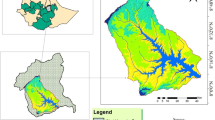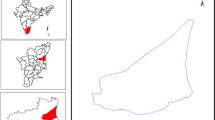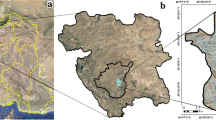Abstract
Flash flood is an extreme flooding event which is quick, short-lived, hazardous phenomena having negative environmental and socio-economic impacts. Flood risk management is essential to reduce the effects of flood on human lives and livelihoods. The main goals of this research were flash flood risk analysis and risk quantification in terms of land use land cover using geo-spatial technology in Shewa Robit town. In the present study, elevation, slope, drainage density, distance from river, NDVI, land use land cover, topographic wetness index and curvature were used as parameters determining flash flood risk. To realize these research objectives, all these data were reclassified in to five classes and different weights for each of them was assigned using analytic hierarchy process. Weighted Sum Overlay (WSO) analyses of ARC GIS software was employed to produce flood vulnerability map. Then, the accuracy of generated flood risk map was validated using historical flood data. According to the result, about 3.08%, 14.62% and 20.66% of Shewa Robit town are at a very high, high and moderate flash flood risk, respectively. In addition to this, flood risk was also quantified in terms of land use land cover. The result indicates that the settlement land use is the most vulnerable with an estimated area of 12.01 ha, 99.57 ha and 174.16 ha in very high, high and moderate risk classes. The outcome of the study will be applicable in flood hazard management and mitigation strategies.













Similar content being viewed by others
Data availability
Not applicable.
Code availability
Not applicable.
References
Abdelfattah M, Saber M, Kantoush SA, Khalil MF, Sumi T, Sefelnasr AM (2017) A hydrological and Geomorphometric approach to Understanding the generation of Wadi flash floods. Water 9(553):1–27. https://doi.org/10.3390/w9070553
Abdelkareem M (2017) Targeting flash flood potential areas using remotely sensed data and GIS techniques. Nat Hazards 85(1):19–37
Ali A, Rumana K, Ateeque A, Syed N (2019) Application of GIS‑based analytic hierarchy process and frequency ratio model to food vulnerable mapping and risk area estimation at Sundarban region, India. Modeling Earth Systems and Environment. https://doi.org/10.1007/s40808-019-00593-z
Ayalew L, Yamagishi H, Ugawa N (2004) Landslide susceptibility mapping using GIS-based weighted linear combination, the case in Tsugawa area of Agano River, Niigata Prefecture Japan. Landslides 1(1):73–81
Berz G, Kron W, Loster T, Rauch E, Schimetschek J, Schmieder J (2001) World map of natural hazards—a global view of the distribution and intensity of significant exposures. Nat Hazards 23(2–3):443–465
Bhasin RE, Grimstad JO, Larsen AK, Dhawan R, Singh SK, Verma, (2002) Landslide hazards and mitigation measures at Gangtok. Sikkim Himalaya. Eng Geol 64(4):351–368
Bhat SA, Meraj G, Yaseen S, Bhat AR, Pandit AK (2013) Assessing the impact of anthropogenic activities on spatiotemporal variation of water quality in Anchar lake. Kashmir Himalayas Int J Environ Sci 3(5):1625–1640
Bhat SA, Meraj G, Yaseen S, Pandit AK (2014) Statistical assessment of water quality parameters for pollution source identification in Sukhnag stream: an inflow stream of lake Wular (Ramsar Site), Kashmir Himalaya. J Ecosyst 2014, Article ID 898054, 18 pages
Bhuyian C, Singh RP, Flügel WA (2009) Modelling of ground water recharge-potential in the hard-rock Aravalli terrain, India: a GIS approach. Environ Earth Sci 59(4):929–938
Bisht S, Chaudhry S, Sharma S, Soni S (2018) Assessment of flash flood vulnerability zonation through Geospatial technique in high altitude Himalayan watershed, Himachal Pradesh India. Remote Sens Appl 12:35–47
Borga M, Anagnostou EN, Bloschl G, Creutin JD (2011) Flash flood forecasting, warning and risk management: the HYDRATE project. Environ Sci Policy 14(7):834–844. https://doi.org/10.1016/j.envsci.2011.05.017
Cao C, Xu P, Wang Y, Chen J, Zheng L, Niu C (2016) Flash flood hazard susceptibility mapping using frequency ratio and statistical index methods in coalmine subsidence areas. Sustainability 8(9):948
Central Statistical Authority (2012) 2007 population and housing census of Ethiopia. Administrative report, Addis Ababa
Chen J, Hill AA, Urbano LD (2009) A GIS-based model for urban flood inundation. J Hydrol 373:184–192
Coppock JT (1995) GIS and natural hazards: an overview from a GIS perspective. In: Carrara A, Guzzetti F (eds) Geographical information systems in assessing natural hazards. Kluwer, Dordrecht, pp 21–34
Costa JE (1987) Hydraulics and basin morphometry of the largest flash floods in the conterminous United States. J Hydrol 93:313–338
Cunderlik JM, Burn DH (2002) Analysis of the linkage between rain and flood regime and its application to regional flood frequency estimation. J Hydrol 261(1–4):115–131
Dahri ZH, Abbasi SS, Ahmad B, Ali M, Anwar MZ, Habib N, & Naz R (2017) The Indus Basin: A glacier-fed lifeline for Pakistan. HI-AWARE Working Paper, 11.
Das S (2019) Geospatial mapping of flood susceptibility and hydro-geomorphic response to the floods in Ulhas basin, India. Remote Sens Appl 14(2019):60–74. https://doi.org/10.1016/j.rsase.2019.02.006
Dobler C, Hagemann S, Wilby RL, Stätter J (2012) Quantifying different sources of uncertainty in hydrological projections in an Alpine watershed. Hydrol Earth Syst Sci 16:4343–4360
Fernández DS, Lutz MA (2010) Urban flood hazard zoning in Tucumán Province, Argentina, using GIS and multicriteria decision analysis. Eng Geol 111(1–4):90–98
Fischer E, Conrad O, Bechtel B, Bock M, Dietrich H, Gerlitz L, Böhner J (2015) System for automated geoscientific analyses (SAGA) v. 2.1. 4. Geosci Model Dev Discussions, 8(2).
Gardiner V (1990) Drainage basin morphometry. In: Goudie A (ed) Geomorphological techniques. Unwin Hyman, London, pp 71–81
Groisman PY, Knight RW, Easterling DR, Karl TR, Hegerl GC, Razuvaev VAN (2005) Trends in intense precipitation in the climate record. J Clim 18(9):1236–1350. https://doi.org/10.1175/jcli3339.1
Haeng HJ, Salas JD, Boes DC (2001) Regional flood frequency analysis based on a Weibull model, part 2 Simulations and applications. J Hydrol 242(3–4):171–182
Haghizadeh A, Siahkamari S, Haghiabi AH, Rahmati O (2017) Forecasting food-prone areas using Shannon’s entropy model. J Earth Syst Sci 126:39. https ://doi.org/10.1007/s1204.0–017–0819-x
Horritt MS (2000) Calibration of a two-dimensional finite element flood flow model using satellite radar imagery. Water Resour Res 36(11):3279–3291
Horritt MS, Bates PD (2002) Evaluation of 1D and 2D numerical models for predicting river flood inundation. J Hydrol 268:87–99
Horton RE (1945) Erosional development of streams and their drainage basins; hydro physical approach to quantitative morphology. Geol Soc Am Bull 56:275–370
Hudson PF, Kesel RH (2000) Channel migration and meander-bend curvature in the lower Mississippi River prior to major human modification. Geology 28(6):531–534
Inter-governmental Panel on Climate Change (IPCC) (2007) Climate Change, impacts, adaptation and vulnerability. In: Parry ML, Canziani OF, Palutikof JP, et al (eds) Contribution Group II to the fourth assessment report of the intergovernmental panel on climate change. Cambridge University Press, Cambridge
Kayastha P, Dhital MR, De Smedt F (2013) Application of the analytical hierarchy process (AHP) for landslide susceptibility mapping: a case study from the Tinau watershed, west Nepal. Comput Geosci 52:398–408
Kharraz JE, El-Sadek A, Ghaffour N, Mino E (2012) Water scarcity and drought in WANA countries. Procedia Eng 33:14–29
Köplin N, Addor N, Rössler O, Huss M, Weingartner R, Seibert J (2014) Robust changes and sources of uncertainty in the projected hydrological regimes of Swiss catchments. Water Resour Res 50(10):7541–7562
Kumar PK, Gopinath G, Seralathan P (2007) Application of remote sensing and GIS for the demarcation of groundwater potential zones of a river basin in Kerala, southwest coast of India. Int J Rem Sens 28(24):5583–5601
Kundzewicz ZW (2002) Non-structural flood protection and sustainability. Water Int 27(1):3–13
Landau S, Mitchell RAC, Barnett V, Colls JJ, Craigon J, Payne RW (2000) A parsimomious, multiple-regression model of wheat yield response to environment. Agric Forest Meteorol 101(2–3):151–166
Leopold LB, Miller JP, (1956) Ephemeral streams; Hydraulic factors and their relation to the drainage net. Tech. rep
Mahmoud SH, Gan TY (2018) Urbanization and climate change implications in flood risk management: developing an efficient decision support system for flood susceptibility mapping. Sci Total Environ 636:152–167
Mason SJ, Waylen PR, Mimmack GM, Rajaratnam B, Harrison JM (1999) Changes in extreme rainfall events in South Africa. Clim Change 41(2):249–257. https://doi.org/10.1023/a:1005450924499
McBean G (2004) Climate change and extreme weather: a basis for action. Nat Hazards 31(1):177–190
Meraj G, Romshoo SA, Yousuf AR (2012) Geoinformatics approach to qualitative forest density loss estimation and protection cum conservation strategy- a case study of Pir Panjal range, J&K. India Int J Curr Res Rev 04(16):47–61
Moore ID, Grayson RB, Ladson AR (1991) Digital terrain modelling: a review of hydrological, geomorphological, and biological applications. Hydrol Process 5:3–30
Murray V, Ebi KL (2012) IPCC Special report on managing the risks of extreme events and disasters to advance climate change adaptation (SREX). J Epidemiol Community Health. https://doi.org/10.1136/jech-2012-201045
Nageswararao K, Swarna LP, Arun KP, Hari KM (2010) Morphometric analysis of Gostani River Basin in Andhra Pradesh state, India using spatial information technology. Int J Geomat Geosci 1(2):79–187
Omran A, Schroder D , Elrayes A, Geriesh M (2011) Flood hazard assessment in Wadi Dahab, Egypt based on basin morphometry using GIS techniques. GI_Forum Program Committee.
Ozdemir H, Bird D (2009) Evaluation of morphometric parameters of drainage networks derived from topographic maps and DEM in point of floods. Environ Geol 56:1405–1415
Patton PC (1988) Drainage basin morphometry and floods. In: Baker VR, Kochel RC, Patton PC (eds) Flood geomorphology. Wiley, New York, pp 51–65
Peduzzi P, Dao H, Herold C, Mouton F (2009) Assessing global exposure and vulnerability towards natural hazards: the Disaster Risk Index. Nat Hazards Earth Syst Sci 9(4):1149–1159
Pilling CG, Jones JAA (2002) The impact of future climate change on seasonal discharge, hydrological processes and extreme flows in the Upper Wye experimental catchment Mid-Wales. Hydrol Process 16(6):1201–1213
Pradhan B, Shafie M (2009) Flood hazard assessment for cloud prone rainy areas in a typical tropical environment. Dis Adv 2(2):7–15
Rai PK, Chandel RS, Mishra VN, Singh P (2018) Hydrological inferences through morphometric analysis of lower Kosi river basin of India for water resource management based on remote sensing data. Appl Water Sci. 8(15). https://doi.org/10.1007/s13201–018–0660–7.
Rai PK, Chaubey PK, Mohan K, Singh P (2017) Geoinformatics for assessing the inferences of quantitative drainage morphometry of the Narmada Basin in India. Appl Geomat 9(3):1–23. https://doi.org/10.1007/s12518-017-0191-1
Ritter DF, Kochel RC, Miller JR (1995) The Drainage Basin. In: Process Geomorphology. 3rd Ed. Waveland Pr Inc.
Romshoo SA, Rashid I (2014) Assessing the impacts of changing land cover and climate on Hokersar wetland in Indian Himalayas. Arab J Geosci 7(1):143–160
Rouse Jr JW, Haas RH, Schell JA, & Deering DW (1974) Paper A 20. In: Third earth resources technology satellite-1 symposium: the proceedings of a symposium held by goddard space flight center at Washington, DC on December 10–14, 1973: Prepared at Goddard Space Flight Center (Vol. 351, p. 309). Scientific and Technical Information Office, National Aeronautics and Space Administration.
Saaty TL, (1980) The Analytic Hierarchy Process: Planning, Priority Setting, Resource Allocation. McGraw-Hill Book Co, New York, pp. 287
Sanyal J, Lu XX (2004a) Application of remote sensing in flood management with special reference to monsoon Asia—a review. Nat Hazards 33:283–301
Sanyal J, Lu XX (2004b) Application of remote sensing in flood management with special reference to monsoon Asia: a review. Nat Hazards 33(2):283–301
Sharma A, Singh P, Rai PK (2018) Morphotectonic analysis of Sheer Khadd River basin using geospatial tools. Spat Inf Res https://doi.org/10.1007/s41324-0180185-z
Shuvasish K and Manasi D (2020) Flash food risk assessment for drainage basins in the Himalayan foreland of Jalpaiguri and Darjeeling Districts, West Bengal. Modeling Earth System and Environ. https://doi.org/10.1007/s40808-020-00807-9
Skilodimou H, Livaditis G, Bathrellos G, Verikiou-Papaspiridakou E (2003) Investigating the flooding events of the urban regions of Glyfada and Voula, Attica, Greece: a contribution to Urban geomorphology. J Geografiska Annaler 85A(2):197–204
Smith LC (1997) Satellite remote sensing of river inundation area, stage, and discharge: a review. Hydrol Process 11:1427–1439
Soni S (2017) Assessment of morphometric characteristics of Chakrar watershed in Madhya Pradesh India using geospatial technique. Appl Water Sci https://doi.org/10.1007/s13201-016-0395-2.
Soni SK, Tripathi S, Maurya AK (2013) GIS based morphometric characterization of mini-watershed—Rachhar Nala of Anuppur district Madhya Pradesh. Int J Adv Technol Eng Res 3(3):32–38
Soulsby C, Tetzlaff D, Hrachowitz M (2010) Spatial distribution of transit times in mountain catchments: conceptualization tools for management. Hydrol Process 24:3283–3288
Šraj M, Viglione A, Parajka J, Blöschl G (2016) The influence of non-stationarity in extreme hydrological events on flood frequency estimation. J Hydrol Hydromech 64(4):426–437
Strahler AN (1964) Quantitative geomorphology of drainage basin and channel networks. Handbook of applied hydrology.
Tripathi S, Soni SK, Maurya AK (2013) Morphometric characterization & prioritization of sub- watersheds of Seoni River in Madhya Pradesh, through remote sensing & GIS technique. IJRSG 2(3):46–54
Verstappen HT (1995) Aerospace technology and natural disaster reduction. In: Singh RP, Furrer R (eds) Natural hazards: monitoring and assessment using remote sensing technique. Pergamon Press, Oxford, pp 3–15
Waikar ML, Nilawar AP (2014) Morphometric analysis of a drainage Basin using geographical information system: a case study. Int. J. Multidiscip Curr Res 2
Watson RT, Haeberli W (2004) Environmental threats, mitigation strategies and high mountain areas. Mountain Areas 13:2–10
Wheater H (2002) Hydrology of Wadi Systems: IHP Regional Network on Wadi Hydrology in the Arab Region. UNESCO, Paris
Wilby R (2008) A review of recent trends and projected climate changes for Niger. West Africa.
Yakoo Y, Kazama S, Sawamoto M, Nishimura H (2001) Regionalization of lumped water balance model parameters based on multiple regression. J Hydrol 246(1–4):209–222
Youssef AM, Pradhan B, Gaber AFD, Buchroithner MF (2009) Geomorphological hazard analysis along the Egyptian Red Sea coast between Safaga and Quseir. Nat Hazards Earth Syst Sci 9:751–766
Zerger A (2002) Examining GIS decision utility for natural hazard risk modeling. Environ Modell Softw 17(3):287–294
Acknowledgements
The authors acknowledge the editor and reviewers for their time, constructive comments and suggestions during the review process. In addition, we acknowledge United States Geological Survey (USGS) and European Space Agency (ESA) for the free provision of DEM and Sentinel data sets.
Funding
Not applicable.
Author information
Authors and Affiliations
Contributions
Optional: please review the submission guidelines from the journal whether statements are mandatory.
Corresponding author
Additional information
Publisher's Note
Springer Nature remains neutral with regard to jurisdictional claims in published maps and institutional affiliations.
Rights and permissions
About this article
Cite this article
Dejen, A., Soni, S. Flash flood risk assessment using geospatial technology in Shewa Robit town, Ethiopia. Model. Earth Syst. Environ. 7, 2599–2617 (2021). https://doi.org/10.1007/s40808-020-01016-0
Received:
Accepted:
Published:
Issue Date:
DOI: https://doi.org/10.1007/s40808-020-01016-0




